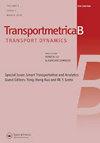基于列生成的ATFM框架,包含用户驱动的优先级排序过程
IF 3.4
2区 工程技术
Q2 TRANSPORTATION
引用次数: 0
摘要
本文章由计算机程序翻译,如有差异,请以英文原文为准。
A column generation-based framework for ATFM incorporating a user-driven prioritization process
A column generation-based framework is proposed for air traffic flow management (ATFM) incorporating a user-driven prioritization process (UDPP). Airspace Users' (AUs') preferences and priorities can be explicitly reflected in the framework. AUs are allowed to propose their preferred routes as initial options and AUs' delay cost structure can be customized and not revealed to other AUs. Major UDPP features, including Fleet Delay Reordering, Selective Flight Protection, and Margins, are fully incorporated in the proposed framework. In the master problem, the model selects 4D-routes for flights subject to sector capacity constraints. In the subproblems, new 4D-routes are generated. Numerical experiments demonstrate that the proposed framework can efficiently solve the ATFM problem considering UDPP features with often zero or small optimality gaps. The effectiveness of UDPP is also verified using case studies. Parallelism of subproblems considerably further reduces the runtime and the large-scale scenario computational time can be reduced to around 30 min.
求助全文
通过发布文献求助,成功后即可免费获取论文全文。
去求助
来源期刊

Transportmetrica B-Transport Dynamics
TRANSPORTATION SCIENCE & TECHNOLOGY-
CiteScore
5.00
自引率
21.40%
发文量
53
期刊介绍:
Transportmetrica B is an international journal that aims to bring together contributions of advanced research in understanding and practical experience in handling the dynamic aspects of transport systems and behavior, and hence the sub-title is set as “Transport Dynamics”.
Transport dynamics can be considered from various scales and scopes ranging from dynamics in traffic flow, travel behavior (e.g. learning process), logistics, transport policy, to traffic control. Thus, the journal welcomes research papers that address transport dynamics from a broad perspective, ranging from theoretical studies to empirical analysis of transport systems or behavior based on actual data.
The scope of Transportmetrica B includes, but is not limited to, the following: dynamic traffic assignment, dynamic transit assignment, dynamic activity-based modeling, applications of system dynamics in transport planning, logistics planning and optimization, traffic flow analysis, dynamic programming in transport modeling and optimization, traffic control, land-use and transport dynamics, day-to-day learning process (model and behavioral studies), time-series analysis of transport data and demand, traffic emission modeling, time-dependent transport policy analysis, transportation network reliability and vulnerability, simulation of traffic system and travel behavior, longitudinal analysis of traveler behavior, etc.
 求助内容:
求助内容: 应助结果提醒方式:
应助结果提醒方式:


